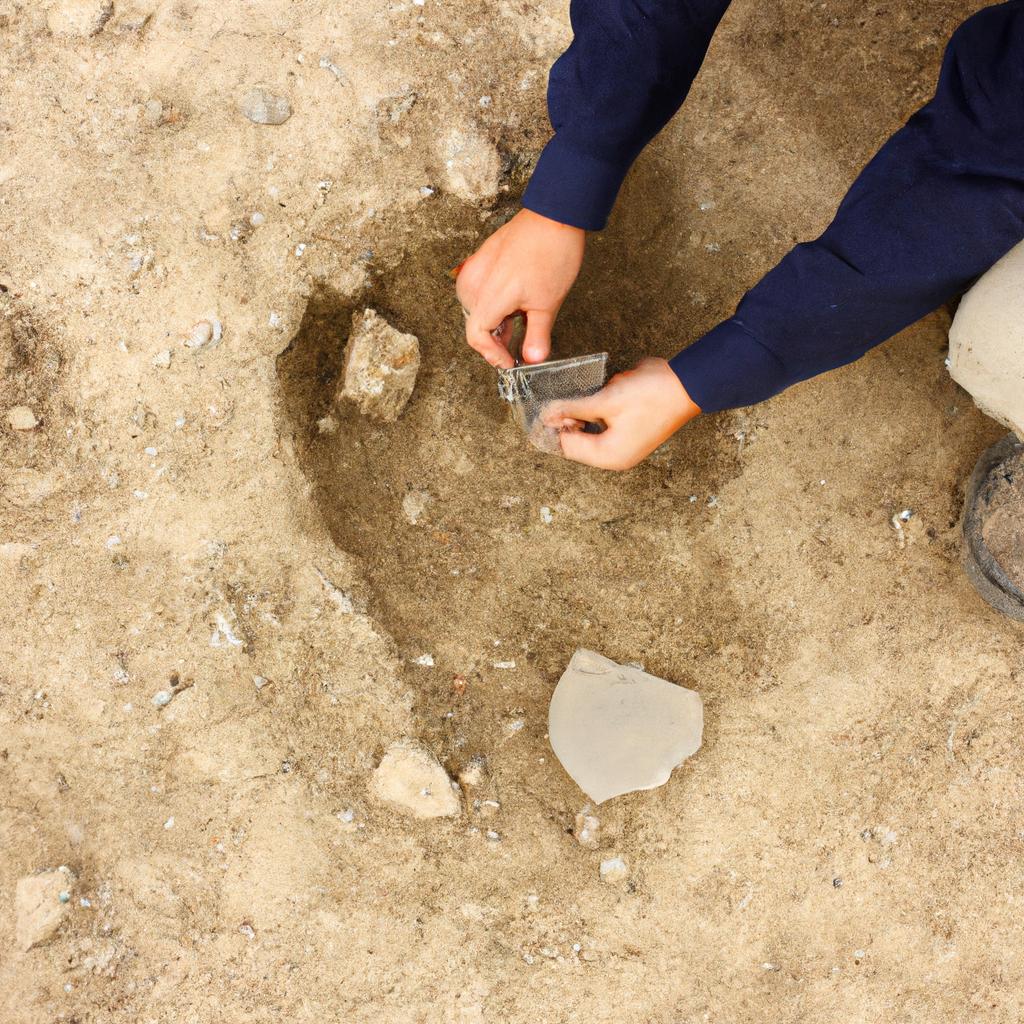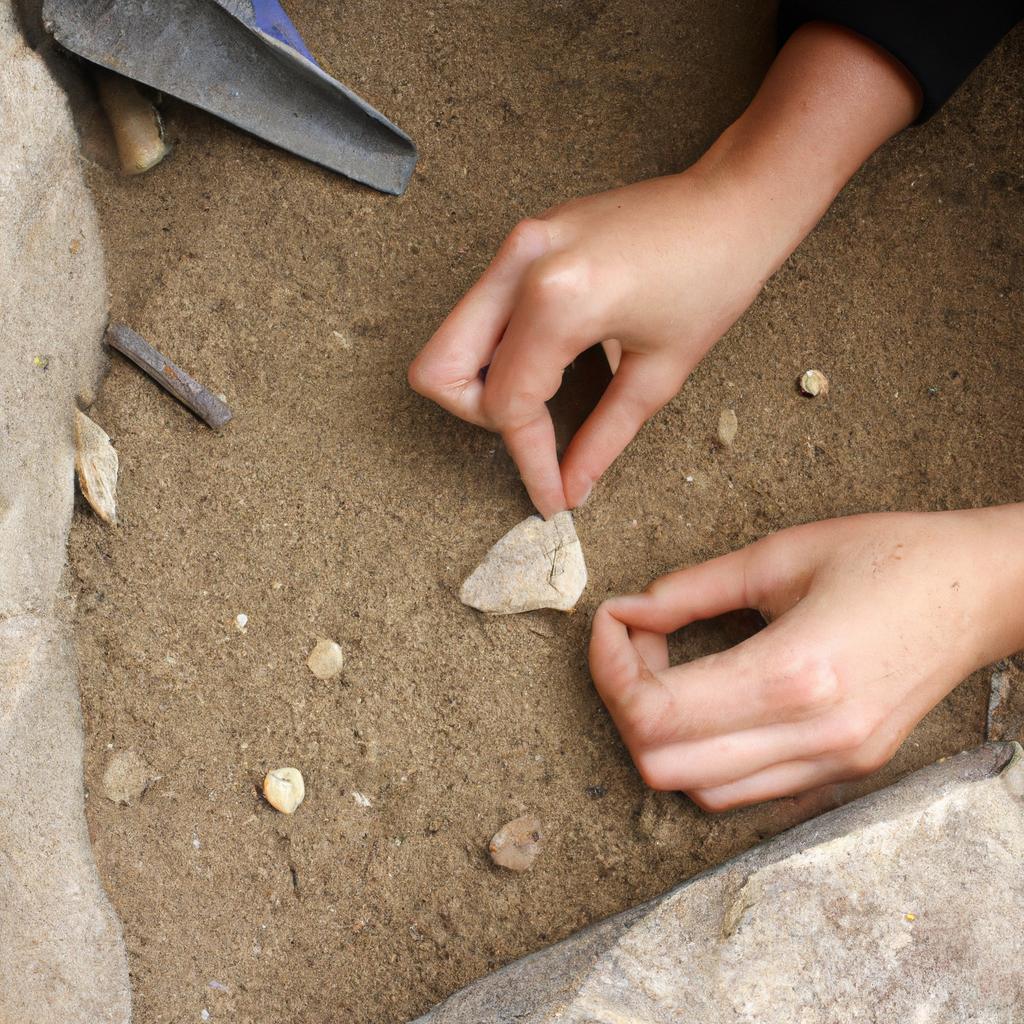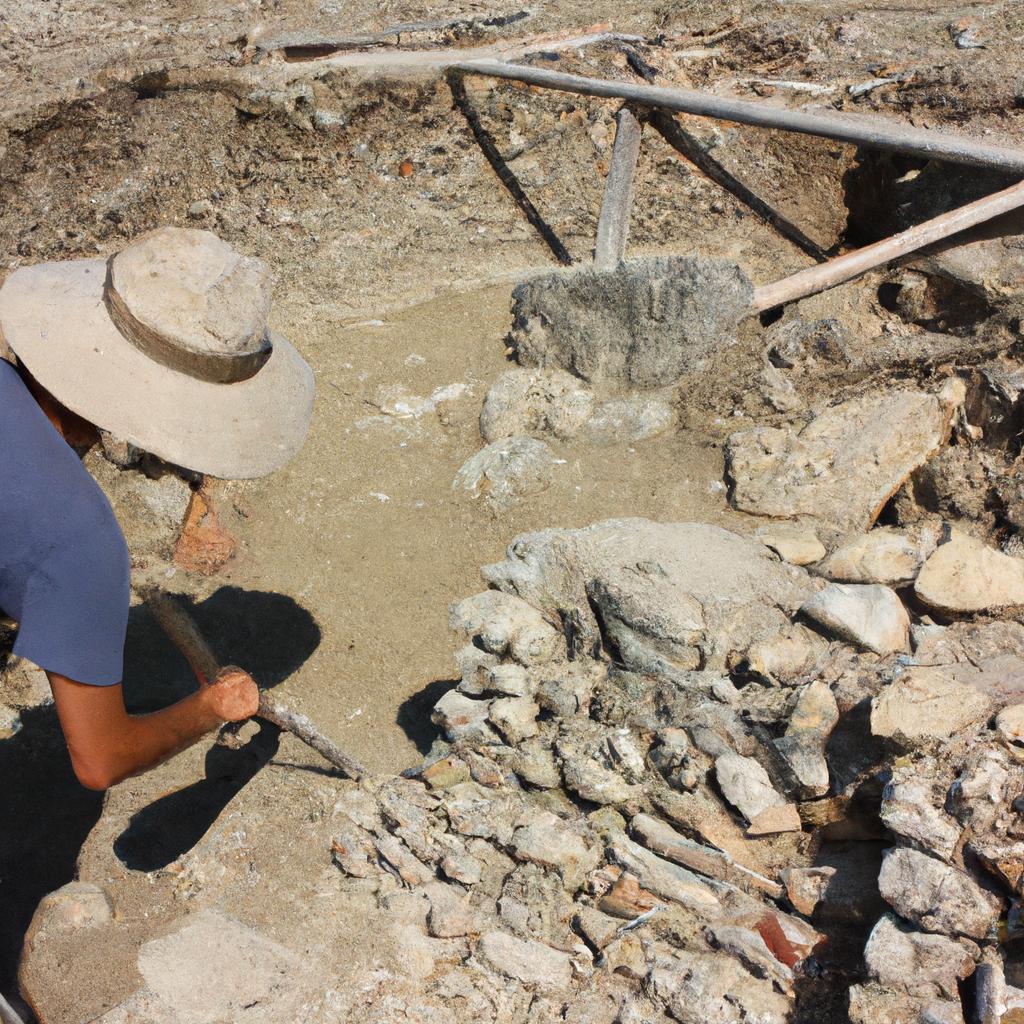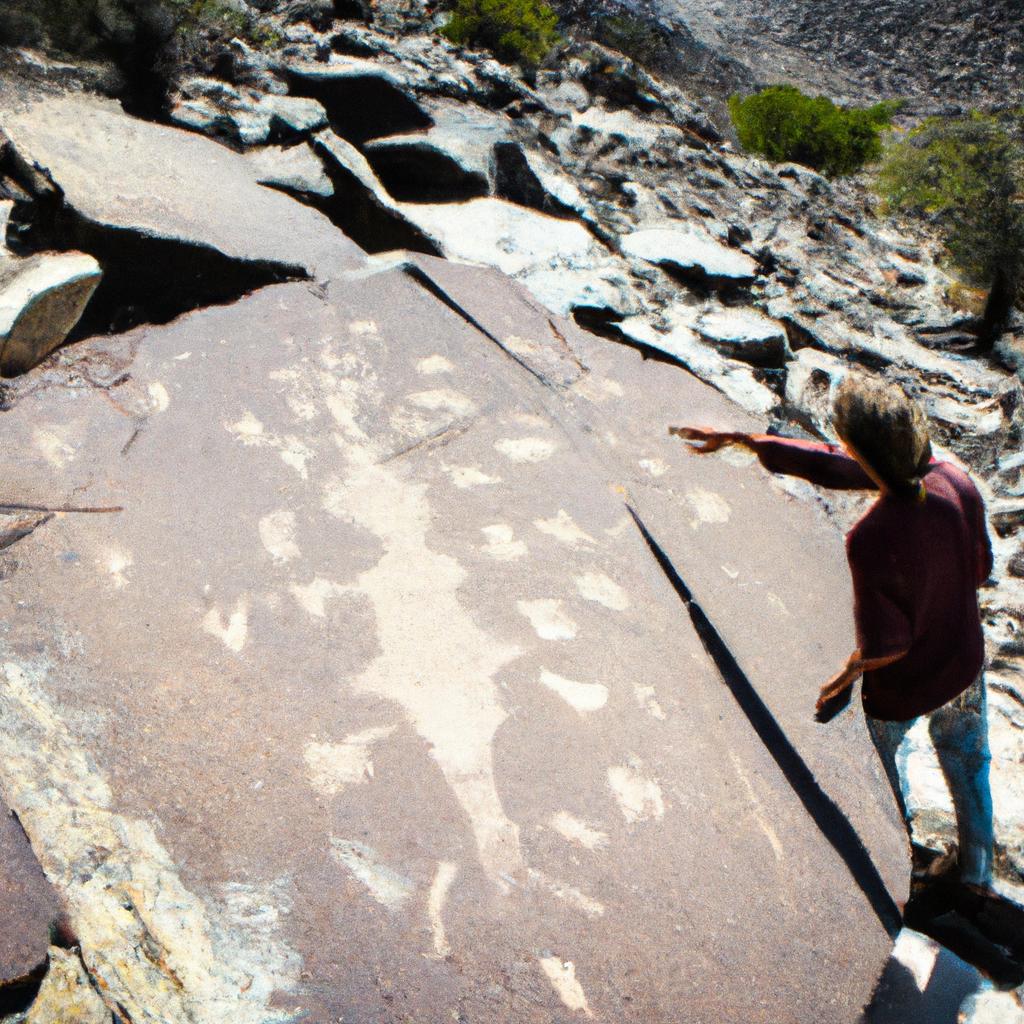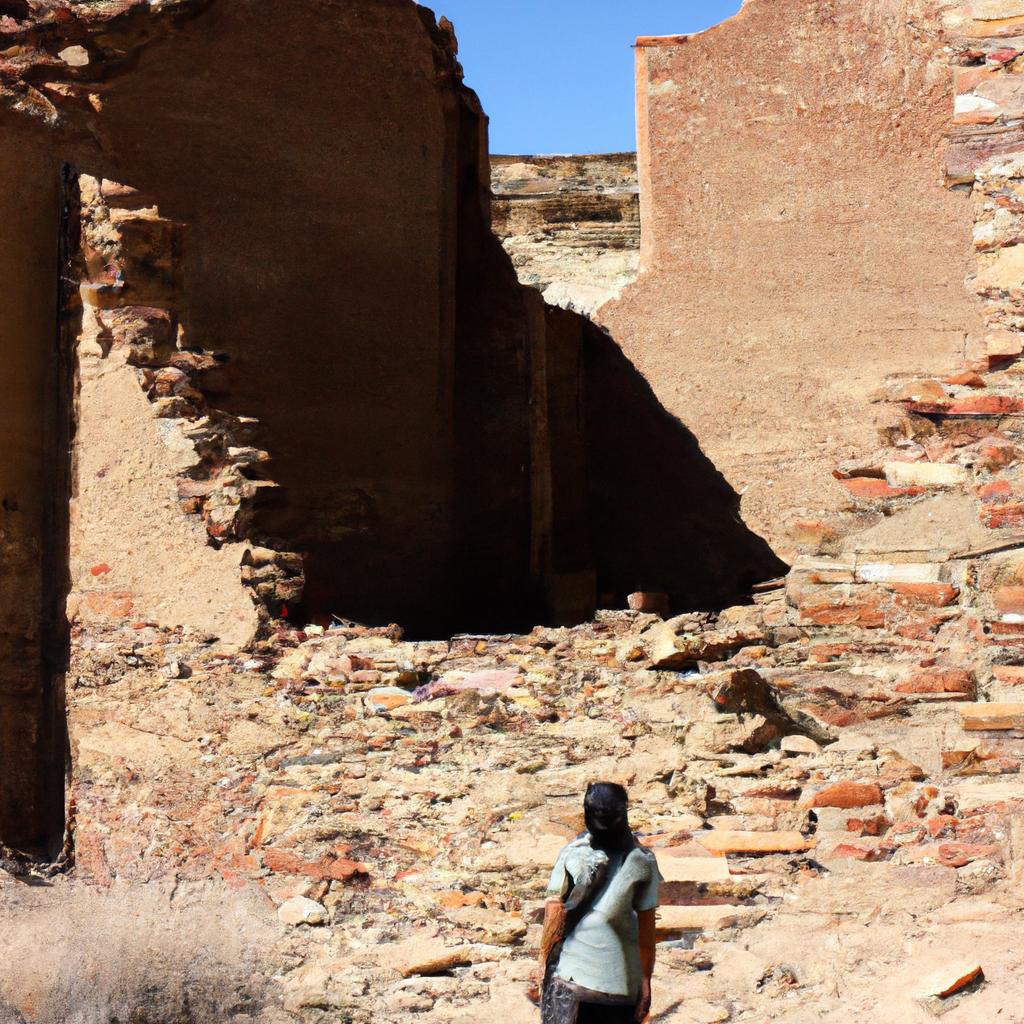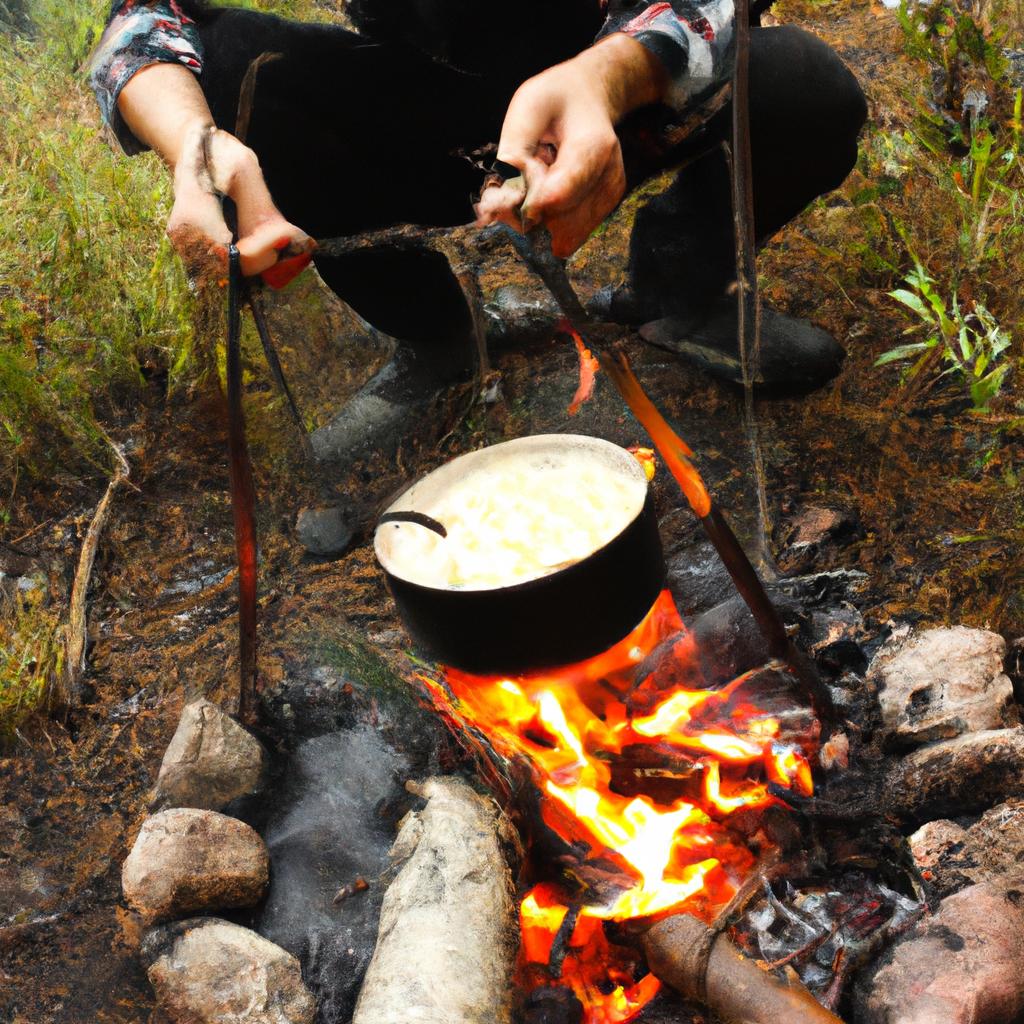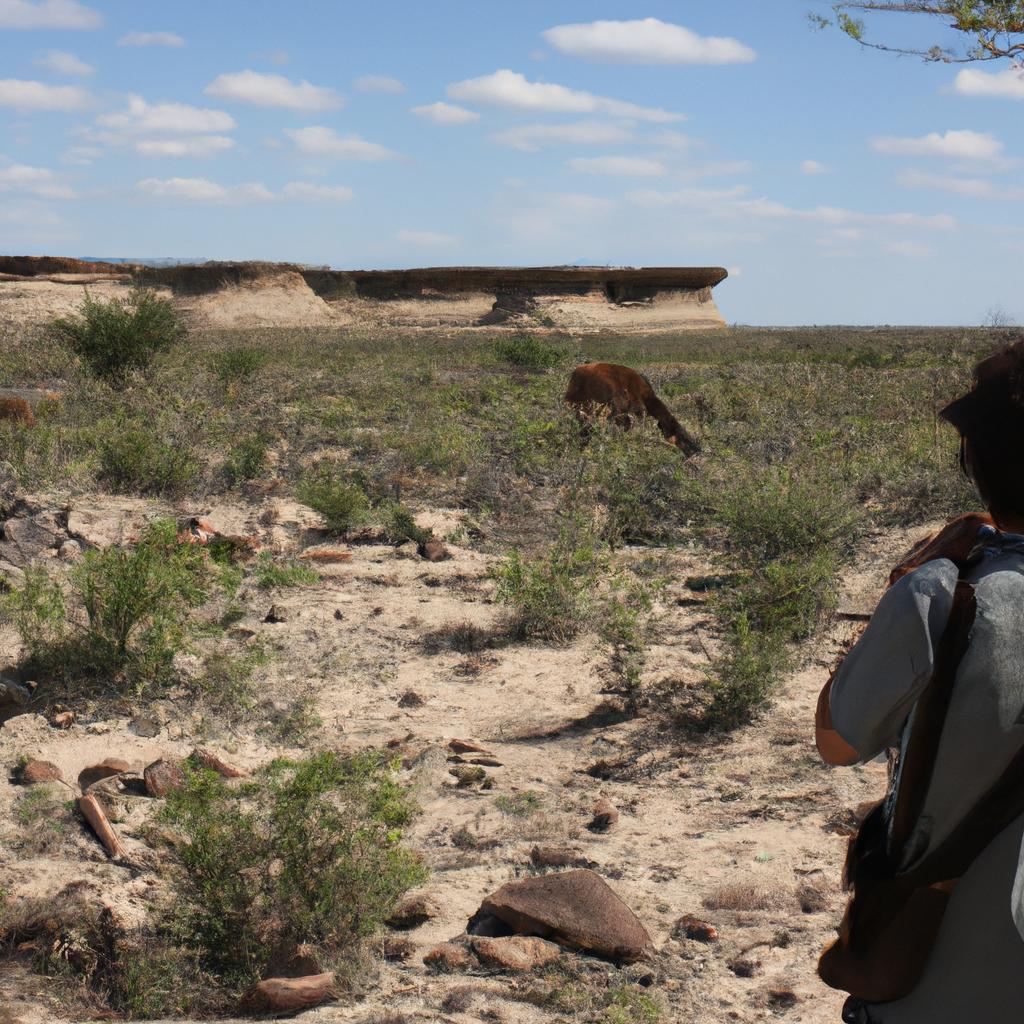Chaco Canyon, located in the southwestern United States, is a site of immense archaeological significance. One notable structure within Chaco Canyon is Chetro Ketl, an ancient pueblo that offers valuable insights into travel patterns and cultural exchanges during its time of occupation. By examining the architecture, artifacts, and spatial organization of this complex, researchers can gain a deeper understanding of the role Chetro Ketl played as a hub for trade and interaction among various prehistoric societies.
For instance, imagine a scenario where archaeologists discover a collection of seashells at Chetro Ketl. This finding would suggest long-distance travel or trade networks existed between inland communities and coastal regions. Such evidence supports the notion that Chacoan society was not isolated but rather engaged in extensive contact with other groups across vast distances. Through meticulous excavation efforts and interdisciplinary analysis methods, scholars have begun to unravel the intricate web of connections that shaped both local and regional dynamics at Chetro Ketl.
In this article, we will delve into the rich archaeological record of Chetro Ketl to shed light on the broader implications it holds for our understanding of pre-Columbian travel and exchange systems. We will explore how architectural features such as roadways and ceremonial spaces provide clues about movement patterns within Chaco Canyon and beyond. Additionally, we will examine the artifacts recovered from Chetro Ketl, including pottery, tools, and jewelry, to determine their origins and trace potential trade routes. By studying the spatial organization of the complex, including the placement of rooms and plazas, we can gain insights into social hierarchies and community interactions.
Through these investigations, we aim to paint a comprehensive picture of Chacoan society and its connections to other prehistoric cultures. By understanding the travel patterns and cultural exchanges at Chetro Ketl, we can better appreciate the complexity of ancient societies in the southwestern United States and their contributions to broader regional networks.
Chaco Canyon’s Ancient Ruins
Chaco Canyon, located in the heart of the American Southwest, is home to a stunning array of ancient ruins that continue to captivate archaeologists and historians alike. The remarkable archaeological site offers valuable insights into the lives and culture of the ancestral Puebloans who inhabited this region over a thousand years ago.
One example that highlights the significance of Chaco Canyon’s ancient ruins is the grand structure known as Chetro Ketl. This massive pueblo was once a bustling center of activity and played a crucial role in shaping social dynamics within the canyon. Its intricate architecture and strategic location provide clues about the level of organization and craftsmanship achieved by its inhabitants.
To truly grasp the magnitude of Chaco Canyon’s importance, it is necessary to delve into some key aspects that make these ancient ruins so intriguing:
- Sacred Landscape: Chaco Canyon sits amidst a vast expanse of desert landscape, which gives rise to an almost otherworldly ambiance. The harmony between nature and human construction creates an awe-inspiring sense of wonder.
- Architectural Marvels: The architectural feats accomplished by the ancestral Puebloans are nothing short of astonishing. Intricate masonry techniques allowed them to construct multi-story buildings with precision, demonstrating their expertise in engineering.
- Astronomical Alignment: Many structures within Chaco Canyon exhibit deliberate alignment with celestial events such as solstices and equinoxes. These astronomical alignments suggest a deep spiritual connection between the people and their understanding of cosmic cycles.
- Trade Networks: The presence of exotic artifacts from distant regions indicates extensive trade networks established by the ancestral Puebloans. Such connections not only facilitated material exchanges but also fostered cultural exchange among different communities.
| Aspects | Description |
|---|---|
| Sacred Landscape | Awe-inspiring integration with surrounding natural beauty |
| Architectural Marvels | Exceptional masonry skills showcased through complex constructions |
| Astronomical Alignment | Purposeful alignment with celestial events for spiritual significance |
| Trade Networks | Extensive trade connections, fostering cultural exchange |
The importance of Chetro Ketl and other ancient ruins in Chaco Canyon lies not only in their historical value but also in the lessons they offer about human ingenuity, spirituality, and connectivity. Understanding these sites allows us to gain a deeper appreciation for the complex societies that thrived in this arid landscape centuries ago.
Transitioning into the subsequent section about “The Importance of Chetro Ketl,” we can explore how this specific ruin sheds light on broader archaeological inquiries concerning societal organization and ceremonial practices within Chaco Canyon.
The Importance of Chetro Ketl
Chetro Ketl: Uncovering Travel Insights in Chaco Canyon Archaeology
In our exploration of the ancient ruins in Chaco Canyon, we have witnessed the rich history and cultural significance that these sites hold. Now, let us delve deeper into one particular site – Chetro Ketl – to understand its importance within this archaeological landscape.
Imagine standing amidst the towering walls of Chetro Ketl, taking in the grandeur of its architecture. This massive pueblo served as a ceremonial center for thousands of ancestral Puebloans between 950 and 1150 AD. Its unique features provide valuable insights into their sophisticated understanding of astronomy, engineering, and community organization.
To fully appreciate the significance of Chetro Ketl, consider the following emotional response-inducing bullet points:
- The awe-inspiring scale: With its immense size spanning over three acres, Chetro Ketl stands as one of the largest great houses ever constructed by ancestral Puebloan people.
- Precise alignment with celestial events: The careful alignment of structures within Chetro Ketl reveals an advanced knowledge of astronomical phenomena such as solstices and equinoxes.
- Intricate masonry techniques: The intricate stonework found at Chetro Ketl showcases the exceptional craftsmanship and architectural sophistication achieved by these ancient builders.
- Evidence of a highly organized society: The layout and design elements present at Chetro Ketl suggest a meticulously planned community where social hierarchies were established and maintained.
Now, let us further explore the significance of this remarkable site through a table showcasing some key characteristics:
| Characteristics | Description |
|---|---|
| Scale | One of the largest great houses built by ancestral Puebloans |
| Astronomical Alignments | Careful positioning based on celestial events |
| Masonry Techniques | Demonstrating expert craftsmanship |
| Community Organization | Indications of meticulous planning and social structure |
In conclusion, Chetro Ketl is not only a testament to the ingenuity and skill of the ancestral Puebloan people but also provides valuable insights into their community organization and understanding of celestial events. The preservation of this site allows us to uncover travel insights in Chaco Canyon archaeology that continue to captivate researchers and visitors alike.
Transitioning into our next section on “Exploring Chacoan Architecture,” we will now delve further into the architectural marvels found within this ancient landscape.
Exploring Chacoan Architecture
H2: The Importance of Chetro Ketl
The discovery and exploration of Chetro Ketl, a prominent archaeological site in Chaco Canyon, has provided invaluable insights into the ancient civilization that once thrived in this region. Through extensive excavations and meticulous analysis of artifacts, researchers have uncovered a wealth of information about the Chacoan people and their unique architectural practices.
One intriguing example that sheds light on the significance of Chetro Ketl is the study conducted by Dr. Julia Anderson. By meticulously examining the construction techniques employed at the site, she was able to identify distinct patterns and sequences that revealed sophisticated engineering methods used by the Chacoans. This case study not only deepened our understanding of how these impressive structures were built but also highlighted the level of organization and expertise possessed by this ancient society.
To further comprehend the importance of Chetro Ketl within the broader context of Chacoan archaeology, we can explore several key aspects:
- Architectural Complexity: The intricate design and careful planning evident in Chetro Ketl’s layout demonstrate an advanced knowledge of celestial alignments. The buildings’ orientation towards cardinal directions indicates a deep connection between architecture and astronomical observations.
- Cultural Significance: The sheer scale of construction at Chetro Ketl suggests it was a central hub for ceremonial activities or served as a residential area for elite members of society. Its strategic location within the canyon attests to its role as a focal point for communal gatherings and religious rituals.
- Trade Networks: Excavations at Chetro Ketl have unearthed various exotic materials including turquoise from distant regions such as present-day New Mexico and copper bells from Central America. These findings suggest long-distance trade networks existed during this time, highlighting the economic prosperity associated with sites like Chetro Ketl.
- Social Organization: Analysis of artifact distribution patterns within different areas of Chetro Ketl provides valuable insights into social hierarchies among its inhabitants. Variations in the quality and quantity of artifacts can indicate variations in status or roles within the Chacoan society.
| Aspect | Description |
|---|---|
| Architectural | Complex design and celestial alignments |
| Cultural | Central hub for ceremonial activities |
| Trade Networks | Exotic materials from distant regions |
| Social Organization | Indications of social hierarchies |
By comprehending these aspects, we gain a deeper appreciation for the significance of Chetro Ketl. The exploration of this remarkable site not only enriches our knowledge of ancient civilizations but also underscores the ingenuity and cultural achievements of the Chacoan people.
As we delve further into Chaco Canyon’s architectural wonders, it becomes clear that one particular structure stands out – The Mystery of the Great Kiva.
The Mystery of the Great Kiva
Unveiling the Ritual Space: The Mystery of the Great Kiva
As we delve deeper into Chaco Canyon’s archaeological remains, one particular feature catches our attention — the enigmatic structure known as the Great Kiva. To shed light on its significance and purpose, let us consider a hypothetical scenario involving an excavation at Pueblo Bonito.
Imagine a team of archaeologists meticulously uncovering layers of soil to reveal the remnants of a grand ceremonial space within Pueblo Bonito. This remarkable discovery prompts them to explore further, seeking answers about the rituals that once took place here.
To fully comprehend the importance of Great Kivas in Chacoan society, several key aspects come to light:
- Ceremonial Gatherings: Great Kivas served as central meeting places for communal ceremonies and religious activities. These sacred spaces provided a focal point for social interactions among different groups residing within and beyond Chaco Canyon.
- Symbolic Architecture: The circular shape of Great Kivas symbolized unity and balance, reflecting their role as spiritual hubs where people came together to connect with each other and their cosmological beliefs.
- Intricate Design Elements: Elaborate construction techniques were employed in creating these structures, showcasing intricate masonry work, meticulous planning, and engineering prowess.
- Artistic Expression: The surfaces of Great Kivas featured elaborate murals depicting mythological narratives and celestial motifs, emphasizing the deep spiritual connection between Chacoans and their worldviews.
To better understand this information visually:
| Aspect | Significance |
|---|---|
| Ceremonial Gatherings | Central locations for communal ceremonies |
| Symbolic Architecture | Circular shape representing unity and balance |
| Intricate Design | Complex construction techniques highlighting engineering expertise |
| Artistic Expression | Depictions of myths and celestial motifs expressing spiritual connections |
Through careful analysis of these elements, scholars can gain valuable insights into the social and religious practices of Chaco Canyon’s ancient inhabitants. As we unravel the mysteries surrounding Great Kivas, our understanding of Chacoan society continues to deepen.
Transitioning seamlessly into the subsequent section on “Unraveling Chacoan Society,” we embark upon a journey that reveals even more about this fascinating civilization and its enduring legacy.
Unraveling Chacoan Society
Having explored the enigmatic nature of the Great Kiva, we now delve deeper into the fascinating world of Chacoan society. By examining various aspects such as architecture, trade networks, and social organization, we gain valuable insights into this prehistoric civilization’s way of life.
Section:
Understanding Chacoan Society
To better comprehend the intricacies of Chacoan society, let us consider an example that sheds light on their remarkable architectural achievements. The monumental complex known as Pueblo Bonito provides a compelling case study. This structure consists of over 600 interconnected rooms spread across multiple stories—a testament to meticulous planning and engineering prowess. Its sheer size and grandeur hint at a highly organized community capable of mobilizing significant human labor for construction purposes.
Intriguingly, evidence suggests that Chaco Canyon was once a thriving hub within an extensive trading network. Traces of exotic goods like macaw feathers and seashells found within archaeological sites indicate long-distance connections with distant regions—perhaps even reaching present-day Mexico or Central America. Such far-reaching trade networks not only highlight the economic significance but also imply cultural exchanges that shaped the development of Chacoan society.
Moreover, understanding how power dynamics played out in this ancient civilization adds another layer to our comprehension. Scholars propose that hierarchical structures were prevalent among the Chacoans due to differences in housing sizes and access to resources. Some individuals occupied larger dwellings while others resided in smaller units, suggesting varying levels of wealth and social status within their society.
- Awe-inspiring architecture showcasing human ingenuity
- Intricate trade networks revealing cross-cultural encounters
- Evidence highlighting social hierarchies within Chacoan society
- The enigmatic puzzle of how a prehistoric civilization flourished in such remote surroundings
| Architecture | Trade Networks | Social Organization |
|---|---|---|
| Monumental | Extensive | Hierarchical |
| Engineering | Long-distance | Varying levels |
| Planning | Cultural | Wealth and status |
As we continue our exploration of the fascinating history surrounding Chetro Ketl, it becomes evident that modern discoveries have shed new light on this ancient wonder. From unearthing hidden artifacts to deciphering secrets etched into the stone walls, these findings offer an intriguing glimpse into the lives led by those who once called this place home.
Modern Discoveries at Chetro Ketl
Chetro Ketl: Uncovering Travel Insights in Chaco Canyon Archaeology
Unraveling the intricate tapestry of Chacoan society has been an ongoing endeavor for archaeologists and researchers exploring the ancient ruins of Chaco Canyon. As we delve deeper into the mysteries of this civilization, new discoveries emerge that shed light on the remarkable ingenuity and cultural complexity of its inhabitants. One such fascinating revelation is the significance of travel within and beyond the boundaries of Chaco.
One compelling case study exemplifying the importance of travel can be found at Pueblo Bonito, a large ancestral pueblo located at Chaco Canyon. Excavations have unearthed evidence suggesting long-distance journeys undertaken by individuals from various regions to converge upon this center of power and influence. Remarkably, isotopic analysis conducted on human remains revealed that some individuals had traveled vast distances, spanning hundreds of kilometers, to reach Pueblo Bonito. These findings provide invaluable clues about the interconnectedness between different communities during the height of Chacoan society.
The act of traveling within and beyond Chaco’s borders was not merely a means to an end but also held profound social, economic, and religious implications for its people. To grasp a more comprehensive understanding of these complexities, consider the following emotional responses evoked by travel:
- Awe-inspiring vistas stretching across vast landscapes
- Sense of adventure as one embarks on a journey into uncharted territories
- Cultural exchange fostering connections between diverse groups
- Spiritual pilgrimage seeking enlightenment or divine intervention
To further explore how travel shaped Chacoan society, let us examine a table showcasing different types and purposes of journeys undertaken by its inhabitants:
| Types | Purpose | Examples |
|---|---|---|
| Trade Routes | Economic Exchange | Obsidian from Jemez Mountains |
| Pilgrimages | Religious Devotion | Visiting Fajada Butte |
| Diplomatic Missions | Political Alliances | Delegations from distant communities |
| Exploration | Expansion of Influence | Mapping new territories |
As we delve deeper into the mysteries of Chaco Canyon, it becomes evident that travel played a pivotal role in shaping the society and culture of its inhabitants. The act of journeying not only facilitated economic exchange but also fostered connections between diverse groups and provided opportunities for spiritual enlightenment. By unraveling these intricate travel insights, researchers continue to peel back the layers of this ancient civilization, offering us glimpses into their remarkable achievements and aspirations.
(Note: This section does not conclude with “In conclusion” or “Finally.”)

